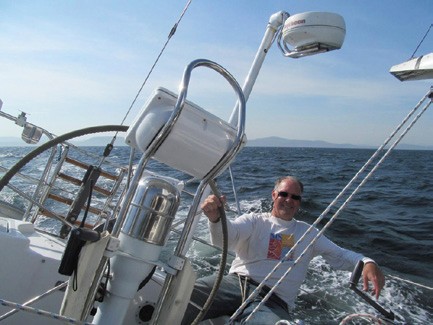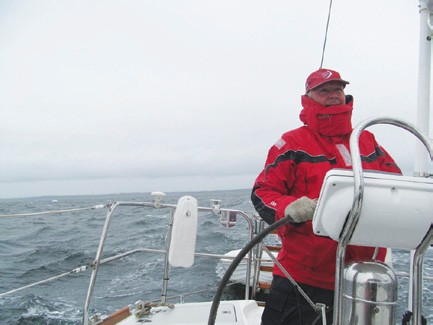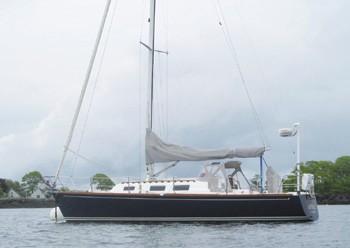By Molly Mulhern
 Not many people go sailing in our neck of the coast early in the season when the wind is blowing over 20 knots. I can understand why. Small Craft Warnings are issued, and well, it is windy! I would not want to go out either, except…
Not many people go sailing in our neck of the coast early in the season when the wind is blowing over 20 knots. I can understand why. Small Craft Warnings are issued, and well, it is windy! I would not want to go out either, except…
A happy helmsman – the sun is out and the wind is blowing! The J/34C is very well balanced when sailed well, requiring a very light touch on the helm when the sails are trimmed properly. © Molly Mulhern
First, I am curious how it is out there. Second, my sailing partner Jim has sailed all his life, and loves to go out when the wind is blowing. Third, if I really want to do some offshore cruising, and I keep saying I do, well then, I need to get over this fear of wind.
How ironic is it, anyway, that the very thing that drives our boats forward also keeps us away? I laugh to recognize my son’s incredulity when I say I don’t like wind – he’s a dinghy sailor and finds high wind a ball. He does not have a lot of experience on keelboats, nor has he read as much as I have about big boat sailing, but I admire his desire for wind. We, as sailors, should embrace it!
So, why don’t I yet embrace a blow? Lack of experience. I dread how I might behave, how the fear will paralyze me. I also dread how the boat will perform. I just don’t know. And this is where Jim comes in. He is a gentle teacher, a man who understands boats and how they are designed, has sailed a lot of boats in a lot of conditions, and cares greatly how these sailing experiences go for me. This makes these lessons in high wind much easier.
When we left the house on Saturday, as an afterthought I threw in the wool and the extra layers of fleece. Good thing, because by the end of the weekend the wind chill temp was 46° F. I also checked the NOAA on-the-water forecast before we left and satisfied myself that there was not going to be that much wind. Just further proof that forecasts are just that and highly risky to take as truth. The forecast had fog on both days, wind 15-20, NNE. This was a bit of fiction.
When we got to the boat it was sunny and breezing up over 20 knots from the SSE. Jim set about changing the #2 jib down to the blade. It was blowy on the foredeck and the piles of canvas were sedated with a few well-placed sail ties. The weekend was proof yet again that the key to dealing with wind is managing the sails – knowing the right combination of canvas, having the right combination of sails aboard, and the willingness to change sails as needed.
Jim led the luff of the blade into its groove while I cranked its halyard aft. It was tough cranking in the breeze, made doubly tough by Jim’s realization, about three-quarters of the way up, that we’d neglected to put in the jib’s vertical battens. I lowered the halyard, went forward to help put the battens into their velcroed batten pockets, sauntered aft and commenced grinding again. It didn’t help that I only had three wraps on the drum when four were needed, nor that I was not using the correct, easier speed on the winch. Lessons.
Okay, blade rigged, then furled. Time to set the double reef on the main. We had practiced this the previous weekend, when it was also windy. Halyard. Tack line. Halyard again. Clew line. Then tie sail stops around the sail (not boom). Got it.
And so we were off. Once past Curtis Island we set the jib, with the “whoosh” that accompanies an eager sail hungrily filled. We began crossing West Penobscot Bay, close-hauled, punching into a strong 1- to 3-foot sea. Jim kept the mainsheet traveler down to minimize heeling for me, driving from the lower rail, watching for pots. The air was warm, the sun was out. Jim, loving the driving, looked as comfortable as a kid cruising along no-hands on a bike. The wind was blowing a steady 20, the boatspeed averaging 7.5 knots, almost hullspeed for our 34-foot vessel. I kept offering Jim his foul weather coat or fleece, as he sat in a cotton shirt, buffeted by the air. The occasional wave breaking over the bow didn’t quite reach him, instead exhausting itself on the dodger I sat under. Astraea danced along, heeled over 15-20 degrees, although to me it felt more like 40 or 50 degrees.
I have a lot to learn – I nestled in and got used to sailing on an angle. Planning for a nice broad reach back home the next day. The world is good. Maybe I can do this. I craned my neck around and saw that North Haven Island, our night’s destination, was but 200 yards off. I had kind of expected that the breeze, now SSW, blowing up the large expanse of Penobscot Bay, would have been moderated by the shore and that we would have been in a lee. Instead I noted, as did Jim, there were stronger gusts by the shore. The wind indicator rocketed to 30 knots frequently. Jim mentioned something about wind increasing over the island and shooting down onto the water. Then a 40+ gust hit us at the mouth of Pulpit Harbor. Astraea went up on edge, like a ballet dancer en pointe, straining with all she had. I turned back to watch Jim ease the mainsheet and simultaneously point her up to the wind, which flattened the boat, the wind pressure having been taken off the sails. He did it all so smoothly, and Astraea responded in kind. I felt like I had pulled myself back from the edge of the cliff…and I had not even done anything. I was not at the helm, nor the sheets, and yet I couldn’t help but be affected.
We rolled in the blade as we entered the harbor mouth. With the wind on the nose it would be tight tacking and Jim knew I don’t need any more of a workout, although he’d relish the challenge. He also started the diesel, scoping out the wind in the outer harbor, where we were pleased to see the gorgeous, 94-foot Fife ketch Belle Aventure anchored. There was one lone crew on the deck as we motorsailed by, looking as if he wished he were aboard our little craft instead of babysitting the large vessel. The six large fenders deployed on her port side hinted at a large tender in use someplace, although at the time we did not sight her. (Later we discovered the tender is a Hinckley Picnic boat that most of us would consider outrageous as our only boat!)
I tossed and turned all night as the wind howled through the rigging. It was blowing SSW over the treetops across the water and onto Astraea. What does this trite expression “howling in the rigging” mean? All I can say is there is this constant sound, and constant boat motion. Not constant as in the same, but constant in that it keeps up…rising in the gusts, falling in the lulls, but persistent. There is a hum and a shuddering that occurs when the wind is sustained over 20, and Jim could sense the nuance (I almost typed nuisance!) when the gusts get over 30 – and this night there were periods of this 30+ frequency. I don’t yet have the experience to sense the nuances.
Jim sleeps like a baby on the mooring. And why shouldn’t he? Before we said goodnight, I asked him about chafing on the pendant line that we rigged from the too-big mooring line. He said it would be fine. He said you could hear chafe – it also has a certain frequency – an audible rubbing. This I did not know. As I lay there, warm and cozy beside his slumbering body, I was not worried about chafe. I wasn’t worried about the mooring slipping the way you worry about an anchor dislodging. No, I was worried about wind, whether it would keep blowing and we’d have to sail back in a windy day, too. I was not exactly in the present moment. I was in the future moment, Sunday’s sail.
Somehow I managed a little rest between periods of wind-fret. After the day dawned I got up and make tea, coming back into the bunk, tea in hand, and miraculously there was a slight lull. I thought maybe we’d have a nice, calm sail home. Ha. Within 20 minutes the whistle through the rig was back, and without getting out of the bunk I knew we had switched end-to-end in the harbor, and the wind was now from the north. I don’t know much about weather, but I gathered this meant the front was passing.
We took our time rising and readying for the sail home. Rain was spitting on the deck, the wind was rising and then lulling. Again we checked NOAA and SailFlow, only to be lured again into something about 14-16 knots of wind. Ha.
 We dropped the mooring with a double reef in the main and no headsail. Jim had the engine in neutral, hoping the breeze could carry us out. As we headed west toward the mouth of Pulpit, the waves increased 1-2 feet inside the large rock at the entrance. Our ability to sail against this was minimal, so Jim punched the RPMs to get us out.
We dropped the mooring with a double reef in the main and no headsail. Jim had the engine in neutral, hoping the breeze could carry us out. As we headed west toward the mouth of Pulpit, the waves increased 1-2 feet inside the large rock at the entrance. Our ability to sail against this was minimal, so Jim punched the RPMs to get us out.
The second day of our adventure brought a totally different mood to the empty waters. Jim dressed for the weather (note the wool gloves), leaving Pulpit Harbor on North Haven. © Molly Mulhern
Outside the harbor the gray of the Bay was broken by the white of the wave tops blowing off…a steady 22-25 out of the north, with not much hope of that abating for a while. And so, there we were. Double reefed main only, going 6.5 knots. Rain spitting down, on this day Jim was in full foulies with non-cotton layers underneath, wearing the wool fingerless gloves I had thrown in at the last minute, “just in case.” A heavy chop, cold air, rain, winds steady and gusting high 20s, over 30 at times. Not exactly what I had imagined when I checked NOAA at home less than 24 hours earlier.
And so it is with sailing. Sometimes you don’t get what you expect, and you have to be able to cope with what you get. This is my fear factor. If Jim were to somehow go overboard on a day like this, would I cope? I don’t feel ready to cope with that emergency, and that’s what makes me nervous. I realize how much I am petrified and I know I need to experience more of this to work through these fears. I know my body was tense sailing across that gray, windy Penobscot Bay, just hoping for it to be over soon. I worked on relaxing during the sail…breathing, feeling the tightness…but pretty much failed at getting to a relaxed state.
Does high wind feel worse when the sky is gray and it’s raining and cold? Probably. Does it feel worse when the sea is a heavy chop? Yes, most definitely.
We did not deploy the blade until the tide at the mouth of Camden Harbor was stalling us down to 3.5 knots. Once we set the jib the speed shot to 7.5/8 knots and the boat steadied. Yes, we should have set it sooner. We would have been home sooner and my guts would have been less woozy, I suspect. But Jim knew the heel would have bothered me.
Maybe one day the heel (I had mistyped “hell”…) won’t bother me. I am working on it. Maybe one day I will be able to sleep soundly and solidly on a mooring when the wind is howling. Until then I will keep trying. Thank you Jim, for your kindness as a sailing partner and teacher. Thank you Astraea for being a seakindly, solid, well-designed boat. (She’s a J/34C.)
Other Lessons This Trip
Make sure the plug is in the dinghy. We managed to save the gear from a complete soaking via quick haulout once I’d noticed water filling the bottom of Sweet Pea.
When you find a lone piece of hardware on the deck, figure out what it came from – don’t ignore it. Keen-eyed Jim had spotted a bolt aft, just below the radar as we started sailing in the 3-5 foot seas off the mouth of Pulpit. Looking up, he figured it came from the radar mount – the spring yard crew clearly hadn’t tightened all the bolts. He requested an Allen wrench, so I dove below and brought back the set. Jim asked me which I would rather, the job of replacing the bolt or taking the helm. I took the helm, hating each second of it, afraid I was to sink our boat by taking a wave into the cockpit. My solution was to drive Astraea a bit more into the wind, so the seas weren’t breaking over the middle of the vessel. It steadied me and the boat a bit. Needless to say, I couldn’t wait to give the helm back to Jim and re-nestle into my somewhat warm, dry spot under the dodger, facing aft so I couldn’t see the size of the waves Jim was driving into. I was glad I had taken a turn at the helm the previous weekend, driving us a bit downwind in a sloppy sea. Jim’s coaching about anticipating the sea was good – my execution, not so good. I have a lot of practice to do on this boat.
Other Ponderings
 Why do we do this thing of going out on a sailboat in conditions that will frighten us and make us uncomfortable? Is it to discover our edge? Is it because we are adrenaline junkies and need stimulation? Is it because being the wild of the elements is primal, and we have a sailboat to test ourselves in? Anna Len Elled, the On Board Reporter for the all-female Team SCA in the Volvo Ocean Race 2014-15, summed it up in a few short reasons that apply to me, too (paraphrased):
Why do we do this thing of going out on a sailboat in conditions that will frighten us and make us uncomfortable? Is it to discover our edge? Is it because we are adrenaline junkies and need stimulation? Is it because being the wild of the elements is primal, and we have a sailboat to test ourselves in? Anna Len Elled, the On Board Reporter for the all-female Team SCA in the Volvo Ocean Race 2014-15, summed it up in a few short reasons that apply to me, too (paraphrased):
Astraea in Camden Harbor, ready for her next adventure. © Molly Mulhern
- Adventure – the drive of my life.
- Contrasts – the highs and the lows.
- The sky, the sea, and its wildlife. Sunrises and sunsets, clouds, waves…never cease to amaze me.
- The boat bubble – the life on a boat is tough but simple. It’s addictive. Some people get addicted to life at sea. I’m afraid I’ve become one of them.
I would add to Anna’s list that this kind of experience stretches us, expands our beliefs in what we can do and what we can handle. It feeds that curiosity I mentioned at the beginning. It also enriches and expands the sense of comfort – the warm house, woodstove, and non-tacking bed takes on an entirely new place in contrast to the wet, pitching cockpit. And why do some of us have this curiosity?
Molly Mulhern is a nautical publisher, editor, writer, and champion of all things book- and sailing-related. As past editorial director at International Marine, Molly’s aim has always been to publish books that improve the quality of life for sailors and outdoorspeople, helping them achieve their dreams. She is now consulting and acquiring books for a New York trade publisher. Molly sails and races her Tanzer 22 Ripple out of Rockland, and her J/34C Astraea out of Camden, Maine. Molly is helping the Rockland Yacht Club set up a sailing mentor exchange, volunteering her services as Women’s Sailing Mentor.




